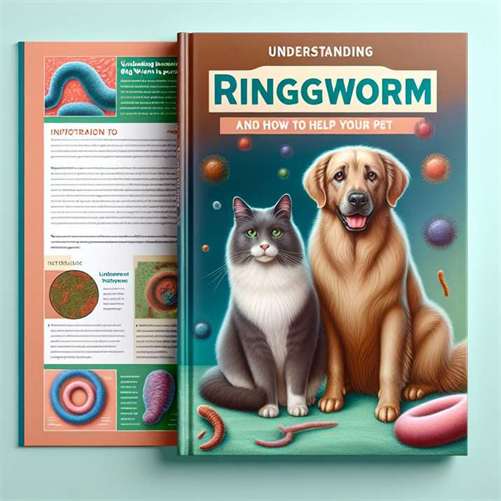Understanding Ringworm Infections and How to Help Your Pet
Introduction
Understanding Ringworm Infections and How to Help Your Pet is a topic that every pet owner should be familiar with. Did you know that ringworm is not actually a worm, but a fungal infection that affects the skin, hair, and nails of animals and humans alike? This engaging fact is just the tip of the iceberg when it comes to understanding this common yet often misunderstood condition. With an increasing number of pets being diagnosed with ringworm, it’s crucial for pet owners to be informed about its causes, symptoms, and treatments.
In recent years, the prevalence of ringworm infections has surged, partly due to an uptick in shelter adoptions and the movement of animals between shelters, which can facilitate the spread of fungal spores. Moreover, the rise of social media has made it easier for pet owners to share their experiences, further highlighting the importance of being educated on this topic. Recent studies suggest that understanding ringworm infections can lead to better preventative measures and quicker recovery times for our furry friends.
In this article, we will delve deep into the realm of ringworm infections, covering everything from what they are, how they manifest in pets, to effective treatments and prevention strategies. By the end of this article, you will have a comprehensive understanding of how to recognize and manage ringworm infections, ultimately ensuring a healthier life for your pet.
For more insights on various pet health topics, check out our article on how to maintain a healthy balanced diet for your pets. Let’s embark on this journey of Understanding Ringworm Infections and How to Help Your Pet together.
What is Understanding Ringworm Infections and How to Help Your Pet?
Definition
Understanding Ringworm Infections and How to Help Your Pet involves recognizing the signs, symptoms, and treatment options for this common fungal infection. Ringworm, or dermatophytosis, is caused by a group of fungi known as dermatophytes. These fungi thrive on keratin, a protein found in the skin, hair, and nails of mammals. When your pet gets infected, it can lead to hair loss, scaly patches, and sometimes severe itching.
Historical Context
The history of Understanding Ringworm Infections and How to Help Your Pet can be traced back centuries. The term “ringworm” dates back to the Middle Ages, stemming from the belief that the infection was caused by worms. In reality, it is a fungal infection that can affect any mammal, including humans. Historically, ringworm was treated with various methods, including herbal remedies, but with the advent of modern medicine, antifungal treatments have become the standard approach.
The Importance of Understanding Ringworm Infections and How to Help Your Pet
In recent years, the importance of Understanding Ringworm Infections and How to Help Your Pet has grown significantly. Factors contributing to this trend include:
- Increased Pet Adoptions: More pets are being adopted from shelters, which may have higher incidences of fungal infections.
- Awareness and Education: Pet owners are becoming more educated about pet health issues, thanks to resources available online and through veterinary clinics.
- Health Implications: Ringworm can also be transmitted to humans, making it vital for pet owners to recognize and address the infection promptly.
Awareness and understanding can significantly reduce the spread of ringworm and protect both pets and their owners. By cultivating this knowledge, pet parents can ensure a safer, healthier environment for their furry companions.

Symptoms of Ringworm Infections in Pets
Understanding the symptoms of ringworm is crucial for early diagnosis and treatment. Here are some common signs to look out for:
Common Symptoms
- Hair Loss: Patches of hair loss, particularly on the face, ears, and tail.
- Scaly Skin: Red, scaly patches that may appear inflamed.
- Itching and Discomfort: Pets may scratch or bite at affected areas.
- Fungal Spores: In some cases, you may notice tiny black dots (fungal spores) in the fur.
Diagnosis
If you suspect your pet has ringworm, it’s essential to consult a veterinarian. They may perform a Wood’s lamp examination, where a special light is used to detect fungal infections. Additionally, they may take a sample of the affected skin or fur to send for laboratory analysis.
Understanding these symptoms will help you act swiftly, ensuring your pet receives the necessary care. For more information on how to care for your furry friend, check out our guide on how to introduce cats and dogs to each other.
Treatment Options for Ringworm Infections
Once diagnosed, several treatment options are available. The approach can vary based on the severity of the infection and your pet’s overall health.
Topical Treatments
- Antifungal Creams: These are often applied directly to the affected areas. Common antifungal creams include clotrimazole and miconazole.
- Medicated Shampoos: Shampoos containing antifungal agents can help eliminate the fungus from your pet’s skin.
Oral Medications
In more severe cases, your veterinarian may prescribe oral antifungal medications, such as:
- Griseofulvin
- Itraconazole
These medications work by attacking the fungus from the inside out, effectively treating the infection.
Environmental Management
Since ringworm spores can linger in the environment, it’s crucial to take steps to eliminate them. Here’s how:
- Clean Bedding and Toys: Wash your pet’s bedding and toys regularly in hot water.
- Disinfect Surfaces: Use a diluted bleach solution or other antifungal sprays to clean surfaces your pet frequents.
- Limit Contact: Keep your pet away from other animals until the infection has cleared completely.
Implementing these treatment strategies can significantly improve your pet’s condition. For further tips on maintaining your pet’s well-being, consider our article on the benefits of pumpkin for your dog or cat.
Preventing Ringworm Infections in Pets
Prevention is always better than cure, and there are effective strategies to minimize the risk of ringworm infections.
Hygiene Practices
- Regular Grooming: Regularly groom your pet to check for any signs of skin issues.
- Frequent Bathing: Bathe your pets with antifungal shampoos if they are at higher risk.
Social Interactions
- Limit Exposure: If your pet has been in contact with an infected animal, limit their interactions with other pets until you’re sure they are not infected.
Vaccination and Health Checks
- Routine Veterinary Visits: Schedule regular check-ups with your veterinarian to monitor your pet’s health.
- Vaccinations: Ensure your pets are up-to-date with vaccinations, as a healthy immune system can help fend off infections.
By integrating these preventive measures into your pet care routine, you can help keep your beloved companions safe from the threat of ringworm. For additional guidance on creating a nurturing environment for your pets, explore our insights on pet custody during break-ups.
Future Trends in Pet Health Related to Ringworm
As awareness of ringworm infections grows, so does the research and innovation surrounding effective treatments and preventive measures. Here are some future trends to watch for:
Emerging Treatments
Research is ongoing to develop more effective antifungal medications with fewer side effects. Innovations in treatment protocols could provide quicker resolution times for infections.
Greater Awareness and Education
With the rise of pet ownership, there is a corresponding increase in public awareness campaigns about common pet health issues like ringworm. This education can empower pet owners to recognize symptoms early and seek timely treatment.
Integration of Technology
Telehealth services are becoming more common, allowing pet owners to consult with veterinarians remotely. This can expedite the diagnosis and treatment process, making it easier for pet owners to address health issues as they arise.
Keeping abreast of these trends will help you remain informed and proactive in ensuring your pet’s health.
Conclusion
In summary, Understanding Ringworm Infections and How to Help Your Pet is crucial for any responsible pet owner. By recognizing the symptoms, seeking timely treatment, and implementing preventive measures, you can protect your pet from this common fungal infection.
As you navigate the responsibilities of pet ownership, remember that knowledge is power. Stay informed and proactive, ensuring that your furry friends lead healthy, happy lives. For more tips and insights on pet care, don’t hesitate to explore our comprehensive blog dedicated to all things pets at Pets Guide.
Ultimately, your diligence can make a significant difference in your pet’s health and happiness, ensuring they remain your loyal companions for years to come.
Resource Links:
- cdph.ca.gov: … … help treat the infection and make your pet more comfortable. For long-haired animals, clipping your pet’s fur short may help the affected …
- morrisanimalfoundation.org: … … signs of ringworm infection as well as understand the facts about this disease. Ringworm Isn’t Just One Fungus. Several species of fungi can …
- vcahospitals.com: Ringworm is the common name given to a fungal infection of the skin, hair, and nails. Ringworm infections can occur in humans and in all domesticated species …




0 Comments